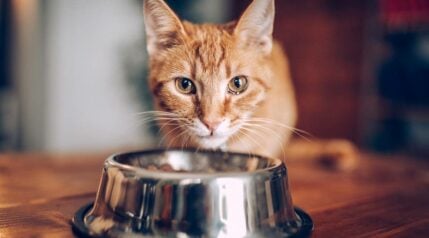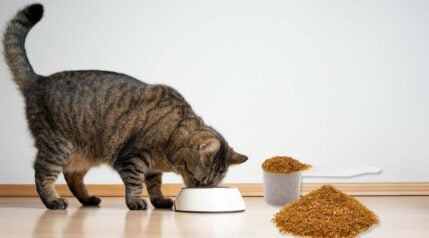When you purchase through links on our site, we may earn a commission. Here’s how it works.
Cats often show interest in what their owners are eating. Sometimes this makes sense. We can’t blame cats if a tasty piece of bacon, a delicious slice of chicken, or even the alluring scent of cheese draws them in. Sometimes though, curious kitties try to eat things that make no sense. One of these odd foods owners might find their cats interested in is jello. This brings up the question, “can cats eat jello?”
While we do not usually expect cats to want sweets, there are times they might just head right for that wiggly bowl of black cherry goodness. They might be drawn in by the wiggly texture, or simply be curious about what their humans are eating. In some cases, cats are fed gelatin, which is an ingredient in jello. Because of this, it is sometimes assumed jello is safe, but the answer is not that simple.
Can cats eat jello? Should they? Is this a food safe for feline consumption? There is a lot of uncertainty about this specific food when it comes to felines, so we decided to get to the bottom of it and give purr parents the answers they need about cats eating jello.
Can Cats Eat Jello?

While one bite or two will not cause much harm, the dessert has a lot of sugar, artificial sweeteners, and artificial additives that make it harmful to them. Felines do not taste sweet, and sugar is not good for them. They should never eat foods high in processed sugars. Jello sometimes contains artificial sweeteners, which are highly toxic to kitties.
What is Jello?
It is an easy dessert to make that has graced dinner tables, lunch cafeteria counters, and snack food aisles for as long as most of us can remember. Jello is mostly made of gelatin, a substance made from animal collagen. It contains sweeteners such as sugar or aspartame, as well as artificial flavors and colors. Sometimes it will be colored with fruit or vegetable juice. Many different ingredients are often mixed in, such as fruit, whipped cream, and sometimes even savory items.
Jello is easy to make at home and comes in easy-to-find powdered boxes. Just mix with hot water, chill, and serve. It even comes in pre-made, snack-size packages making it a common treat found in school lunches. This wiggly sweet is also something people who visit the hospital may be familiar with, as an easy-to-digest food that is often offered in a medical setting.
“Jell-O” is the name of a brand owned by the Kraft company that produces several products, including pudding, Jell-O, and no-bake flavored desserts. Many other companies offer similar gelatin-based dessert products.

Gelatin vs. Jello
It has often been thought that gelatin and jello are the exact same thing, but this is not exactly true. Jello is made from gelatin, flavoring, and sweeteners. Gelatin comes from animal collagen, which is often found in connective tissues like ligaments, tendons, bones, and skin.
Most gelatin we use today comes from the hides and bones of cows and pigs. These parts are first boiled, then dried, treated with an acid or base, and then filtered. The collagen is extracted after filtering, dried, turned into a powder, and used to make gelatin.
Gelatin does not come from horse or cow hooves. This is an often and widely repeated misconception. In fact, those parts of animals cannot be used for this purpose because they are not made up of the right proteins.
Gelatin is also sometimes referred to as gelatine and jelly. It is clear, flavorless, and colorless without added dyes, sweeteners, or flavoring. It is found in many things, including gel caps, cosmetics, and many foods. Some people take supplements to increase the natural production of collagen in their bodies.
Gelatin is found in many foods people eat daily and have no idea about. It is found in many kinds of candy, such as gummy bears, candy corn, Starburst, marshmallows, mints like Altoids, and even in some soft drinks. Gelatin is even sometimes used in the finishing process of wine. Because collagen is derived from animal parts, it is not vegetarian. This is something that people who do not want to eat meat products need to look out for because food containing this ingredient is technically not animal free.
Can Cats Eat Sugar-Free Jello?
Sugar-free is not ever safe for kitties to eat. These contain chemicals that are highly toxic to cats. Xylitol, in particular, can be extremely dangerous to felines. It can trigger insulin release, causing kitties to have very low blood sugar. This is a condition called hypoglycemia. Xylitol can cause liver failure and is often deadly to felines. Even a tiny amount can be enough to cause incredible damage.
Xylitol is a carbohydrate called sugar alcohol found naturally in certain fruits and vegetables. These include berries like raspberries and strawberries. Mushrooms, cauliflower, lettuce, and plums, are also on the list. It is also commercially produced from corn husks and birch bark.
Other artificial sweeteners often used include saccharine (Sweet’N Low), monk fruit sweetener, aspartame, and sucralose (Splenda) are not toxic but are not advisable to feed to cats. They can cause stomach upset, digestive issues, and gastrointestinal discomfort.
Owners should treat things as an emergency if your kitty eats sugar-free jello or other foods containing xylitol. They will need immediate veterinary care.
Signs of xylitol poisoning in felines:
- Weakness
- Difficulty standing and walking
- Seems intoxicated
- Lethargy and very low energy
- Vomiting
- Shaking, tremors, or seizures
The sooner cats get treatment, the higher the chances of recovery. Symptoms can come on very rapidly. While there is no way a veterinarian can test for xylitol in a kitty’s body, they can start treatment right away. Xylitol is also highly toxic to dogs, and they should not eat foods that contain it. Vets may induce vomiting, but this is something pet owners should never try to do at home.
Treatment for xylitol positioning can include hospitalization, blood sugar monitoring, administration of IV fluids, bloodwork, as well as treatment to keep liver function healthy. Cats, especially those older than 7 or 8, can have a much harder time and may suffer more long-term damage.
Can Cats Eat Gelatin?
Plain gelatin, with no ingredients that sweet desserts contain, is safe to feed your kitty. As long as it is meat-based, kitties can safely eat it. Owners can substitute bone, chicken, or beef broth for the water, and turn it into a delicious feline treat. It also is nutritionally beneficial as it contains collagen, protein, and amino acids. Cats who need support for coat, skin, teeth, and joint health are often advised this as a supplement.
In their natural diet, felines get collagen naturally from eating animal proteins, bones, and connective tissues. They should not eat vegan gelatin, as it does not contain any of the collagen that meat-based does and has very little nutritional value for felines.
Collagen is a big part of a feline’s joint, bone, connective tissue, and cartilage health. Having it in their diet can help with conditions like osteoarthritis and hip dysplasia. It can also help boost appetite, lessen joint pain, and promote skin and coat health.
How To Safely Feed A Cat Gelatin
While kitties can safely eat plain, meat-based gelatin, they should not eat too much of it. Kitties who need extra collagen for health reasons can have the powder safely mixed in with their food. Usually, it will be about a teaspoon. Your vet will offer instructions on exactly how much to give based on your pet’s age, weight, and medical needs.
Some commercially made gelatin treats are available, always read the labels and follow serving guidelines. Stay away from vegan and sugary or artificially sweetened gelatins. If using broth make sure it does not have added ingredients like salt, onion, and garlic, which can be harmful to kitties.
Alternative Treats
There are plenty of other options for tasty treats for kitties than jello. Cats do not taste sweet, so there is no need to introduce anything sugary or sweet to them. They prefer meat-based treats. Felines are obligate carnivores, meaning they need high-quality animal proteins to survive. Collagen can be found in many places other than human desserts. Owners need to keep in mind that not all human foods are safe for kitty consumption.
Fresh, human-grade cat food can be a wonderful, safe way to give kitties a boost of collagen. This can be added to your kitty’s regular food and substituted for meals. JustFoodForCats is a delicious, well-made choice that kitties and owners love.
Bone broth is a delicious, nutrient-loaded option that can give kitties a big dose of collagen, aids in digestion, and support bone and joint health. This is a tasty, healthy way to get more moisture into a kitty’s diet as well. It can be added to dry kibble. Bone broth can also be used to make gelatin treats.
Gelatin powder or collagen supplements can be added to your purr baby’s regular diet. Talk to your veterinarian before starting any collagen regimen with your kitty. Make sure you have the correct dose and follow the dosing guidelines of the product used.
Raw or cooked meat like chicken can be given as a nice tasty treat to add flavor and a nutrition boost. Be very careful about giving them chicken bones.
Frequently Asked Questions
My cat ate jello. Should I take her to the emergency vet?
If you suspect your kitty ate jello, call your veterinarian for advice. The course of treatment will depend on the kind and how much they ate. One or two small bites of regular jello may cause discomfort but is not always an emergency. Sugar-free kinds will be a big concern as they contain artificial sweeteners toxic to felines.
Can my cat eat lime jello?
No. Your cat should not eat lime jello. It is not good for felines, and citrus is toxic to them. Do not feed your kitty lime or any other flavored kind. Also, keep felines away from citrus fruits and juices.
Can cats eat unflavored gelatin?
Yes. The unflavored, meat-based kind can be eaten safely by cats. It can be a powder mixed in a treat made with bone broth.
How much jello can a cat safely eat?
It is generally safe for cats to eat a small amount of jello as a treat, but it is important to use moderation. Cats do not need to eat jello as part of their regular diet, and it should not be fed to them in large amounts. A small spoonful of jello once or twice a week is usually sufficient as a treat.
Final Thoughts
Jello is not a safe food to feed felines. Keep them away from this food. It is sugary and full of artificial ingredients that are not part of a feline’s natural diet. The sugar-free kind is even worse for them as it contains toxic artificial sweeteners that can cause felines great harm and even be fatal. Plain, meat-based gelatin is safe and beneficial for cats as it can be a good source of collagen, supporting bone, joint, and skin health.
Always discuss adding collagen to your cat’s diet with your veterinarian. All kitties have individual medical needs, and asking for advice before adding anything to their diet is always best. This guide is for informational purposes only and is not meant to be a substitute for advice for a qualified veterinarian.





